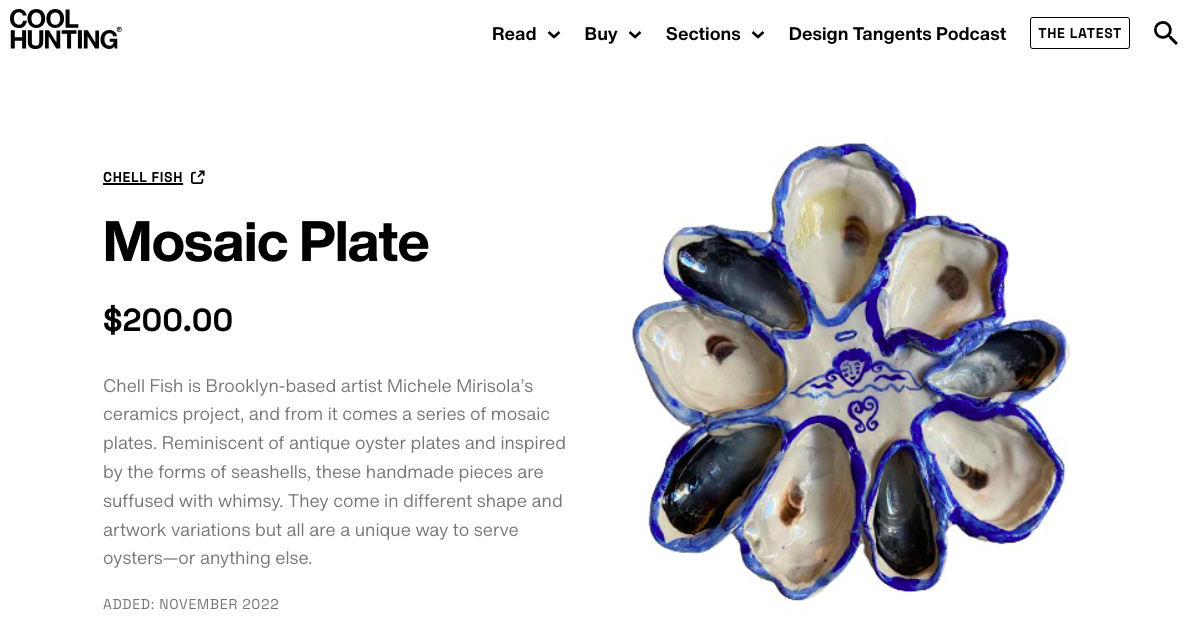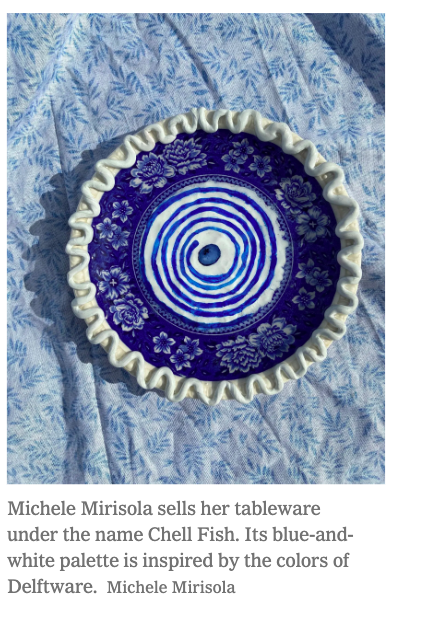
Press
New Visionary Magazine
Issue 15, September 2025
Your series, Chell Fish began with the idea of turning meals into still lifes. Can you share how that origin has evolved—and where your practice sits now between art, craft, and design?
My background is in oil painting and five years ago I created my first shell plate to hold raspberries for a still life painting. From there, the plates took off and enveloped my practice. I use delicate shells and chunky clay with the goal of designing special pieces to take the place of the ordinary. Recently, I’ve been thinking beyond the table. I want to build the objects you’d see in a painting of a grand interior but they’re tangible, imperfectly handmade and something useful everyday. I approach my designs for mirrors and chairs as I do a canvas, thinking about light, color and texture but ultimately making decisions to create pieces that will last, that can show use and love adding to the character of the piece.
You’ve done residencies in Italy, Maine, and upstate New York. How has time in those places influenced your material choices or color palette?
My time in Italy has made the most impact on my work. Along with materials and color-blues and seashells, I have taken a lot of my painting and sculptural imagery inspiration from the Italian frescos, statues, and architectural design: cherubs, moon faces, camellia bushes, and wrought iron fences.
The time I’ve spent in artist residencies has also helped me trust my own taste by taking me out of my shared studio and away from my close friends - who I’m always tempted to ask “Is this finished?” or “Is this the worst piece I’ve ever made?”. The best choices I’ve made during these trips is not to be productive but just give myself mental space to absorb a new world. The work happens when I get back home.
In an increasingly digital world, what role do you think physicality and imperfection play in how we connect to objects?
This is a beautiful moment to be making craft and design. In this hugely digital world, with the rise of AI in the arts, comes a resurgence of love for traditional ways of making and a blending of new media with old. I hope that those who use my pieces will see my hand in it and know a human made this. I personally like to see a chair get scuffed, or a spoon rest get dyed from a beet. I’m a sucker for a dog-eared book with notes in the margin.
How do you move between painting, sculpture, and design? Do they feed each other, or do you treat them as separate languages?
I’m lucky enough to have my job be creating a line of handmade usable tableware. Some of these designs are things I will repeat for 50 orders at a given time. About a year ago that production process was taking over my studio practice and leaving little room for play and inventiveness. This year, with my new collection of art furniture pieces in collaboration with Studio Solenne, I have found an outlet for creative newness.
Now, the varied practices inform each other in new ways. If I don’t want to hand build a pomegranate fifty times, I can paint it with just a few lines and dots. There is a consistent visual language between my worlds of production design and sculpture/painting, drawing from shared imagery in different ways.
Do you imagine your work being used every day, or held for special moments—or both?
I want to create work that people enjoy touching. My work can be hung on a wall, but most of it can be taken down and used as a platter, washed and hung back up to dry. I would hate it if these pieces just collected dust. I create things that reveal their beauty through touch and intimacy. They are, of course, decadent and can be used as a wonderful excuse to throw a dinner party.
For a more homespun option, the artist Michele Mirisola of Chell Fish releases delightfully illustrated platters in limited batches every month, made from epoxy clay and real oyster shells covered in a food-safe resin (she accepts D.M.s for custom orders for any designs that are sold out at her web shop).
March 3, 2023
How did you start your creative tableware line, Chell Fish?
I made my first shell plate because I needed the perfect way to hold raspberries. I was working on a still life painting of fruit and sugar cookies. Up until that point, I had been exclusively painting from life. I wanted a hand in building the things I was making paintings of. During the lockdown, I couldn’t travel to my studio by train, so I was reimagining my materials–from oil paint to gouache. I used an air drying clay and still do, so I never need a kiln. The plate was more interesting to me than the painting it was created for! I added a food safe resin on top so that it could be used over and over again, and it took off from there.
Michele Mirisola, 31, an artist in Brooklyn who owns a set of gilded Homer Laughlin plates, agrees that “if you’re not partying as much in restaurants and bars” fine china is “a way to class up what you’re doing at home.”
Inspired by the colors of Delftware, a style of Dutch tin-glazed pottery, Ms. Mirisola has made a collection of patterned clay tableware in a blue-and-white palette for her line Chell Fish.—Hilary Reid
Michele Mirisola (she/her, artist, writer, birth doula, and creator of Chell Fish): When I couldn’t travel to Bedstuy to get to my studio during NYC’s lockdown, I needed an art practice at home. I created Chell Fish from piles of shells I had held onto, convinced I would one day use them (and I have never been more vindicated). It has been such a pleasure to have my work in Café Forgot and with Your Other Left Ear… Hot tip: you can replace salt with anchovies on almost anything and live a fuller life.















